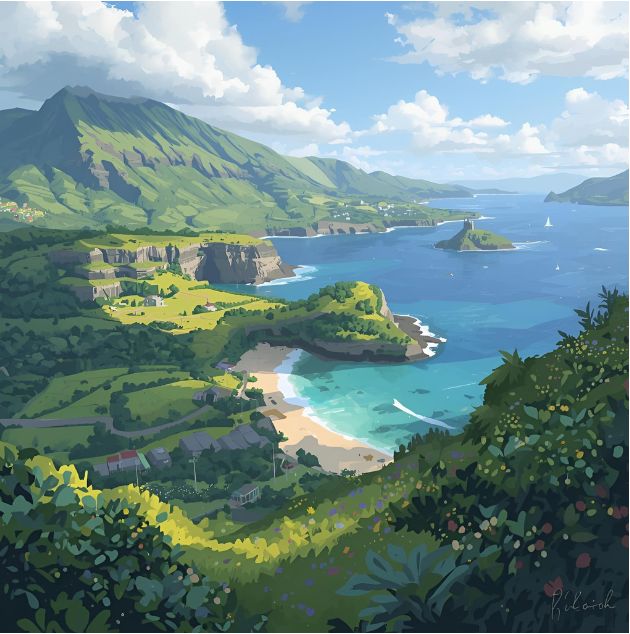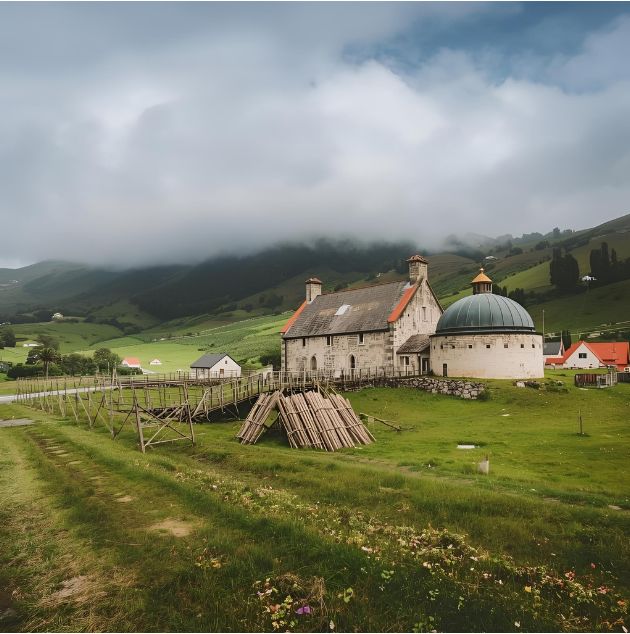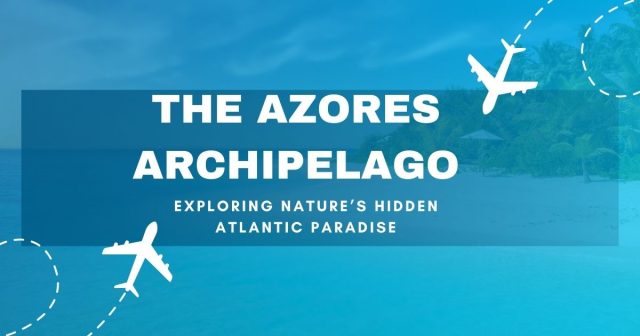Imagine a place where emerald green landscapes cascade into the sapphire blue Atlantic, where volcanic craters cradle mystical lakes, and where whales breach against a backdrop of ancient vineyards. This isn’t a fantasy novel; it’s the Azores, an autonomous region of Portugal and an archipelago of nine volcanic islands adrift in the middle of the ocean. For too long, this remote paradise has flown under the radar of mainstream tourism, remaining a sanctuary for adventurers, nature lovers, and those seeking a profound connection with the raw power of the earth. If you’re searching for a destination that combines the wild beauty of Iceland, the lushness of Hawaii, and the charm of old-world Europe, look no further. This is your complete guide to exploring Europe’s best-kept secret.
What Makes the Azores So Incredibly Special?
The allure of the Azores lies in its authenticity and its staggering natural diversity. It’s a destination that hasn’t been sanitized for mass tourism. Here, sustainability isn’t just a buzzword; it’s a way of life, recognized by its designation as an archipelago-wide UNESCO Global Geopark. What truly sets it apart?
- Volcanic Wonders: From bubbling geothermal springs and natural ocean pools heated by volcanic vents to explorable lava tubes and towering dormant volcanoes, the islands are a living geology lesson.
- A Hiker’s Paradise: Hundreds of miles of well-maintained trails crisscross the islands, leading you through lush forests, along dramatic coastlines, and up to breathtaking crater rims.
- World-Class Marine Life: The Azores are one of the world’s premier locations for whale and dolphin watching, with over 20 different cetacean species, including resident sperm whales, spotted in its waters.
- Unspoiled Culture: Experience charming fishing villages, historic UNESCO World Heritage cities like Angra do Heroísmo, and unique culinary traditions, such as food cooked underground by volcanic steam.
- A Climate of Abundance: Thanks to the mild, subtropical climate, the islands are perpetually green and are home to Europe’s only commercial tea and pineapple plantations.
A Quick Geography Lesson: The Nine Islands
The nine islands are spread across nearly 400 miles of ocean and are typically divided into three distinct groups. Each island has its own unique character, and understanding their layout is key to planning your trip.
The Eastern Group: The Gateway
São Miguel: The largest and most populous island, known as “The Green Island.” It’s the main entry point for international travelers and offers a perfect microcosm of the entire archipelago.
Santa Maria: The southernmost and sunniest island, known for its unique yellowish-sand beaches and drier climate.
The Central Group: The Triangle and Beyond
This is the most geographically concentrated group, making island hopping by ferry relatively easy. Pico, Faial, and São Jorge form the “Triangle Islands.”
Terceira: Home to the UNESCO city of Angra do Heroísmo and famous for its vibrant cultural festivals.
Graciosa: The “White Island,” a tranquil UNESCO Biosphere Reserve with charming windmills.
São Jorge: A long, thin island famous for its dramatic sea cliffs (fajãs) and delicious, spicy cheese.
Pico: Dominated by the magnificent Mount Pico, Portugal’s highest peak, and known for its UNESCO-protected volcanic vineyards.
Faial: The “Blue Island,” thanks to its abundance of hydrangeas, featuring the cosmopolitan marina of Horta and the stark, new volcanic landscapes of Capelinhos.
The Western Group: The Wild Frontier
Flores: Arguably the most beautiful island, a UNESCO Biosphere Reserve renowned for its countless waterfalls and stunning lagoons.
Corvo: The smallest island, a tiny, close-knit community living in the crater of a single volcano.
Island Deep Dive: The Must-Visit Gems for a First-Timer
While every island is worth exploring, a typical first trip focuses on the most accessible islands with the greatest diversity of attractions. Here are the top three to build an itinerary around.

1. São Miguel – The Green Island
São Miguel is the perfect introduction to the Azores. Its capital, Ponta Delgada, is a charming city with mosaic sidewalks and historic architecture. But the real magic lies outside the city. Don’t miss the iconic Sete Cidades, a massive caldera holding two adjacent lakes, one blue and one green, best viewed from the Vista do Rei viewpoint. In the Furnas Valley, witness the earth’s power up close with bubbling mud pots and steaming fumaroles. Here, you can eat Cozido das Furnas, a hearty stew slow-cooked for hours underground by geothermal heat. End your day soaking in the iron-rich thermal waters of Terra Nostra Park or the more rustic pools at Poça da Dona Beija. Finally, visit Europe’s only tea plantations, Gorreana and Porto Formoso, for a taste of locally grown brew.
2. Pico – The Mountain Island
You can’t miss Pico’s namesake: Mount Pico, a stratovolcano that stands at an impressive 2,351 meters (7,713 feet). The challenging three-hour hike to the summit is a rite of passage for adventurers, offering panoramic views of the central islands on a clear day. But Pico is equally famous for what grows at its base. The island’s unique vineyards, a UNESCO World Heritage site, consist of thousands of small, rock-walled plots called currais. These black basalt walls protect the Verdelho grapes from the wind and salt, absorbing heat to help them ripen. A wine tasting here is an essential experience. Pico is also a hub for whale watching, building on its history as a whaling capital to become a center for marine conservation.
3. Terceira – The Cultural Heart
Terceira offers a vibrant splash of color and culture. Its capital, Angra do Heroísmo, is a UNESCO World Heritage city, a beautifully preserved Renaissance town with colorful streets, ornate churches, and a stately fortress. Beyond the city, the island is known for its patchwork of green fields bordered by volcanic stone walls. A unique attraction is Algar do Carvão, an ancient lava tube that you can descend into, exploring a magnificent cavern with an underground lake. Terceira is also the liveliest island, famous for its summer festivals, which include street parties and the controversial but culturally significant running of the bulls.
Planning Your Azores Adventure

The Best Time to Visit
The Azores have a mild, maritime climate, meaning weather can be unpredictable year-round—it’s not uncommon to experience all four seasons in a single day. The peak season is from June to September, offering the warmest temperatures, the most sunshine, and the calmest seas, making it ideal for hiking, swimming, and whale watching. However, the shoulder months of April, May, and October are also excellent choices, with fewer crowds, lower prices, and beautifully lush landscapes, especially with the spring bloom of hydrangeas and azaleas.
Getting There and Getting Around
You can fly directly to São Miguel (PDL), Terceira (TER), or Faial (HOR) from mainland Portugal, several European cities, and a few hubs in North America (Boston, New York, Toronto). To travel between islands, your two options are SATA Air Açores for inter-island flights or the Atlanticoline ferry. Flights are faster and the only option for traveling between island groups in the off-season. Ferries are a scenic and affordable option for island hopping within the Central Group during the summer months. On the islands themselves, renting a car is highly recommended to have the freedom to explore at your own pace.
Where to Stay: From Rustic to Refined
Accommodation in the Azores ranges from modern hotels in Ponta Delgada and Angra do Heroísmo to charming guesthouses and turismo rural properties (rural tourism), which are often beautifully restored farmhouses or manor homes. Booking in advance is crucial, especially if you plan to visit during the summer.
Unforgettable Azorean Experiences
- Hike to an Otherworldly View: Beyond Sete Cidades, try the hike to Lagoa do Fogo on São Miguel or the stunning trails along the fajãs of São Jorge.
- Encounter Giants of the Deep: Take a whale and dolphin watching tour from Ponta Delgada or Pico. Seeing a sperm whale or a pod of common dolphins in their natural habitat is a truly humbling experience.
- Bathe in Earth’s Natural Jacuzzi: Swim in the geothermally heated ocean at Ponta da Ferraria on São Miguel during low tide, or relax in the lush thermal pools of Furnas.
- Taste the Volcano: Beyond the Cozido, sample the famous São Jorge cheese, fresh grilled limpets with garlic butter, sweet Azorean pineapple, and the crisp, mineral-rich white wines from Pico.
- Explore a Lava Tube: Descend into the earth at Gruta das Torres on Pico or Algar do Carvão on Terceira for a fascinating glimpse into the islands’ volcanic origins.
Sample 10-Day Azores Itinerary: Island Hopping Bliss
This itinerary offers a balanced mix of nature, adventure, and culture.
- Days 1-4: São Miguel’s Green Paradise. Arrive in Ponta Delgada (PDL). Explore Sete Cidades, Lagoa do Fogo, the Furnas Valley (eat the Cozido!), and the Gorreana tea plantation.
- Days 5-7: Pico’s Volcanic Majesty. Fly from PDL to Pico (PIX). Dedicate one day to hiking Mount Pico (weather permitting). Spend the other days exploring the UNESCO vineyards, wine tasting, and going on a whale watching tour.
- Days 8-10: Faial’s Blue Hues & History. Take a short ferry from Pico to Faial. Explore the Horta Marina and Peter’s Café Sport, a legendary sailors’ bar. Drive to the Capelinhos Volcano Interpretation Centre to see the land created by the 1957 eruption. Fly home from Horta (HOR).
Travel with Care: Sustainable Tourism in the Azores
The Azores are a precious and fragile ecosystem. As a visitor, you can play a part in preserving their beauty. Always stay on marked trails to prevent erosion, never leave any trash behind, choose responsible tour operators for marine activities, and support local businesses, artisans, and restaurants. By traveling consciously, you help ensure that this Atlantic paradise remains pristine for generations to come.

Conclusion: Your Atlantic Adventure Awaits
The Azores are more than just a destination; they are an experience. It’s a place that forces you to slow down, to breathe in the clean, salty air, and to stand in awe of nature’s artistry. It’s a land of quiet moments and epic adventures, of warm welcomes and unforgettable flavors. The secret is out, but the magic remains. Your journey to the heart of the Atlantic is waiting.
While Embrace the Journey: The Ultimate Guide to the Transformative Art of Slow Travel highlights how taking time enriches the travel experience, The Azores Archipelago: A Complete Guide to Europe’s Best-Kept Secret offers a perfect destination where slow travel truly comes alive. Together, they provide travelers with both the philosophy and the place to create meaningful, memorable adventures.








